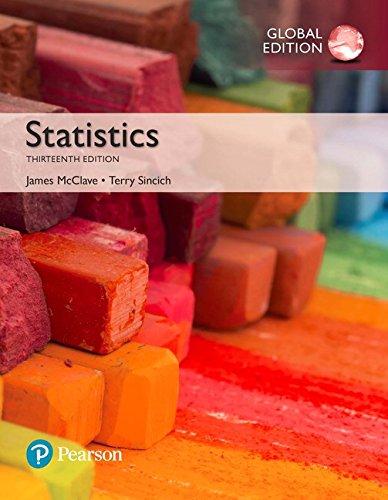Mussel settlement patterns on algae. Mussel larvae are in great abundance in the drift material that washes
Question:
Mussel settlement patterns on algae. Mussel larvae are in great abundance in the drift material that washes up on Ninety Mile Beach in New Zealand. These larvae tend to settle on algae. Environmentalists at the University of Auckland investigated the impact of the type of algae on the abundance of mussel larvae in drift material (Malacologia, Feb. 8, 2002). Drift material from LO4 three different wash-up events on Ninety Mile Beach was collected; for each washup, the algae was separated into four strata: coarse-branching, medium-branching, fine- branching, and hydroid algae. Two samples were randomly selected for each of the 3 * 4 = 12 event–
strata combinations, and the mussel density (percent per square centimeter) was measured for each. The data were analyzed as a complete 3 * 4 factorial design. The ANOVA summary table is as follows:
Source df F p-Value Event 2 .35 7.05 Strata 3 217.33 6.05 Interaction 6 1.91 7.05 Error 12 Total 23
a. Conduct the appropriate ANOVA F-tests (at a = .05)
and interpret the results.
b. Tukey multiple comparisons of the four algae strata means (at a = .05) are summarized in the accompanying table. Which means are significantly different?
Mean 1%>cm22: 9 10 27 55 Algae stratum: Coarse Medium Fine Hydroid Facial expression study. What do people infer from facial expressions of emotion? This was the research question of interest in an article published in the Journal of Nonverbal Behavior (Fall 1996). A sample of 36 introductory psychology students was randomly divided into six groups. Each group was assigned to view one of six slides showing a person making a facial expression.* The six expressions were (1) angry, (2) disgusted, (3) fearful, (4) happy, (5) sad, and (6) neutral. After viewing the slides, the students rated the degree of dominance they inferred from the facial expression (on a scale ranging from -15 to +15). The data (simulated from summary information provided in the article) are listed in the accompanying table.
a. Conduct an analysis of variance to determine whether the mean dominance ratings differ among the six facial expressions. Use a = .10.
b. Use Tukey’s method to rank the six dominance rating means. 1Use a = .05.2 Angry Disgusted Fearful Happy Sad Neutral 2.10 .40 .82 1.71 .74 1.69 .64 .73 -2.93 -.04 -1.26 -.60 .47 -.07 -.74 1.04 -2.27 -.55 .37 -.25 .79 1.44 -.39 .27 1.62 .89 -.77 1.37 -2.65 -.57 -.08 1.93 -1.60 .59 -.44 -2.16
Step by Step Answer:






